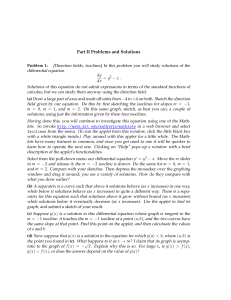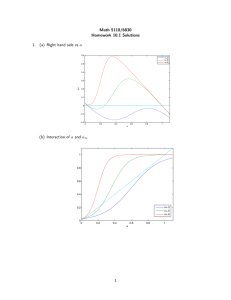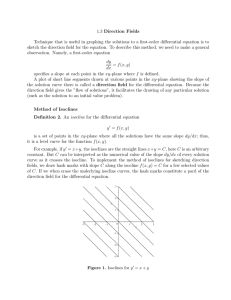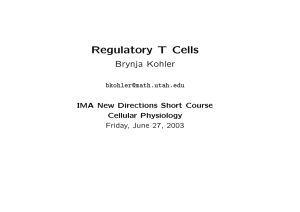Document 13406063
advertisement
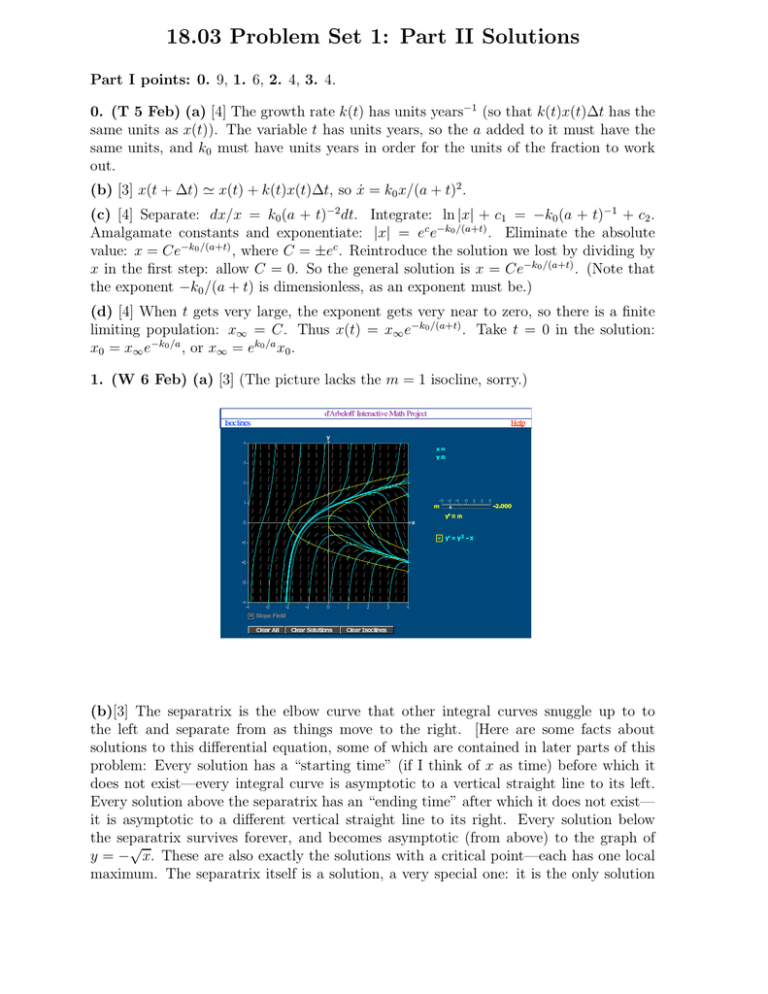
18.03 Problem Set 1: Part II Solutions Part I points: 0. 9, 1. 6, 2. 4, 3. 4. 0. (T 5 Feb) (a) [4] The growth rate k(t) has units years−1 (so that k(t)x(t)Δt has the same units as x(t)). The variable t has units years, so the a added to it must have the same units, and k0 must have units years in order for the units of the fraction to work out. (b) [3] x(t + Δt) � x(t) + k(t)x(t)Δt, so ẋ = k0 x/(a + t)2 . (c) [4] Separate: dx/x = k0 (a + t)−2 dt. Integrate: ln |x| + c1 = −k0 (a + t)−1 + c2 . Amalgamate constants and exponentiate: |x| = ec e−k0 /(a+t) . Eliminate the absolute value: x = Ce−k0 /(a+t) , where C = ±ec . Reintroduce the solution we lost by dividing by x in the first step: allow C = 0. So the general solution is x = Ce−k0 /(a+t) . (Note that the exponent −k0 /(a + t) is dimensionless, as an exponent must be.) (d) [4] When t gets very large, the exponent gets very near to zero, so there is a finite limiting population: x∞ = C. Thus x(t) = x∞ e−k0 /(a+t) . Take t = 0 in the solution: x0 = x∞ e−k0 /a , or x∞ = ek0 /a x0 . 1. (W 6 Feb) (a) [3] (The picture lacks the m = 1 isocline, sorry.) (b)[3] The separatrix is the elbow curve that other integral curves snuggle up to to the left and separate from as things move to the right. [Here are some facts about solutions to this differential equation, some of which are contained in later parts of this problem: Every solution has a “starting time” (if I think of x as time) before which it does not exist—every integral curve is asymptotic to a vertical straight line to its left. Every solution above the separatrix has an “ending time” after which it does not exist— it is asymptotic to a different vertical straight line to its right. Every solution below the separatrix survives forever, and becomes asymptotic (from above) to the graph of √ y = − x. These are also exactly the solutions with a critical point—each has one local maximum. The separatrix itself is a solution, a very special one: it is the only solution √ which lives forever √ but has no maximum and is not asympotic to y = − x. Instead it is asymototic to y = x.] (c) [3] The point of tangency occurs where the tangent line to the m = −1 isocline has slope −1. The m = −1 isocline is the locus of x = y 2 + 1. Differentiate implicitly (using the chain rule) 1 = 2yy �, so if y � = −1 then y = −1/2. The equation then gives x = 5/4, so (a, b) = (5/4, −1/2). √ √ (d) [3] f (x) = − x, or indeed − x + m for any m. The rest of the problem f (x) = √ depends on using f (x) = − x, though, as noted on the website. For large x, y(x) > √ − x, but√ if m < 0 there will be solutions of the type we are considering such that y(x) < − x + m for some x > a. (i) Follow the solution from the x = a line. Suppose that it does cross the m = −1 isocline, and suppose that the first crossing is at a point (x, y). Since it started below the m = −1 isocline, it must be crossing it from below. This means that the slope of the solution must be greater than the slope of the isocline at the crossing point. The slope of the isocline at the crossing point is greater than −1, so the slope of the solution at the crossing point must be greater than −1 too. But when a solution crosses the −1 isocline, it must cross it with slope exactly −1. So it can’t cross it at all. It will be clearer if I don’t try to follow (ii) and (iii) (as explained on the website). (i) shows that solutions y(x) such that y(a) < b are trapped below the −1 isocline. Now I want to say that if a solution is above the lower branch of the nullcline at some point (x, y(x)), then it stays above the nullcline forever more. The slope of the nullcline is negative; the first crossing must be from above; so at the crossing the slope of the solution must be even more negative; but when it crosses the nullcline it must have slope zero. Finally I claim that if (a, y(a)) is below the nullcline, then the integral curve must even­ tually cross the nullcline. Until it does, it is in the region where the direction field has positive slopes. So it is increasing. But the lower branch of the nullcline is is falling; so the two curves must eventually intersect. One can also argue that if the solution never crosses the nullcline then, after rising at the start it must eventually start to fall, since the nullcline does. So it must reach a maximum somewhere in between. But all maxima of solutions occur along the nullcline. (e) [3] Critical points of solutions of y � = y 2 − x occur when y � = 0, that is, along the null-cline: so if there is one at (c, d) then c = d2 . (f) [3] Yes. Here are two arguments: All solutions are increasing for small values of x. From what we can see, the solutions with critical points are the ones which become √ asymototic to the graph of y = − x, which decreases. Also they seem to have just one critical point, which must therefore be a maximum. More complete argument: Compute (as in (c)) y �� = 2yy � − 1. So at a critical point, where y � = 0, we see that y �� = −1. This means maximum. 2. (F 8 Feb) [2] y = x2 , so y(1) = 1. Euler’s method with stepsize h for this equation: xk = kh, yk+1 = yk + 2xk h. [5] With n = 2, h = 1/2: k 0 1 2 xk yk mk = −yk 0 0 0 1/2 0 1 1 1/2 hmk 0 1/2 [5] With n = 3, h = 1/3: k 0 1 2 3 xk yk mk = −yk 0 0 0 1/3 0 2/3 2/3 2/9 4/3 1 2/3 hmk 0 2/9 4/9 [8] With n arbitrary, h = 1/n: k 0 1 2 3 4 .. . xk 0 h 2h 3h 4h .. . yk 0 0 2h2 2h2 + 4h2 2h2 + 4h2 + 6h2 .. . mk = 2xk 0 2h 4h 6h 8h .. . mk h 0 2h2 4h2 6h2 8h2 .. . So yn = 2(1 + 2 + · · · + (n − 1))h2 = n(n − 1)h2 . With h = 1/n this gives our estimate for y(1): n(n − 1)/n2 = (n − 1)/n. The limit of this as n → ∞ is 1, which is good, and the error is 1/n, which is exactly h. 3. (M 11 Feb) (a) [5] Pick a letter to denote the number of years after the fund is set up—say t. Pick a letter to denote function of t giving the value of the fund at time t—say x. In a small time interval from t to t + Δt, the fund increases in value by Ix(t)Δt, but decreases in value by qΔt: x(t + Δt) − x(t) � Ix(t)Δt − qΔt. Divide by Δt and take the limit: ẋ = Ix − q. (b) [5] Separate: dx/(Ix − q) = dt. Integrate: I −1 ln |Ix − q | + c1 = t + c2 . Amalgamate constants and multiply by I: ln |Ix − q| = It + c. Exponentiate: |Ix − q| = ec eIt . Eliminate the absolute value and reintroduce the lost solution: Ix − q = CeIt . Solve for x: x = (q/I) + CeIt (where this C is the earlier one divided by I). (c) [5] Constant trust value means ẋ = 0, which says Ix = q or x = q/I. So with q = 12,000 dollars/year and I = 0.05, x = $240,000. (If Scrooge socks away more than this, then the trust fund could pay out the $1000/month and still grow. But this wouldn’t be Scrooge.) (d) [5] We want to find the constant of integration which makes x(T ) = 0, where T = 20: 0 = x(T ) = (q/I) + CeIT , or C = −(q/I)e−IT . Thus x = (q/I)(1 − e−IT eIt ). Now we can set t = 0 to find the required initial value of the trust: x(0) = (q/I)(1 − e−IT ). With T = 20 and I = 0.05, 1 − e−IT = 1 − e−1 � 0.63212056. Thus the initial funding is about 63% of what it was in (c): x(0) � ($240,000)(.63212056) � $151,708.93. MIT OpenCourseWare http://ocw.mit.edu 18.03 Differential Equations���� Spring 2010 For information about citing these materials or our Terms of Use, visit: http://ocw.mit.edu/terms.
